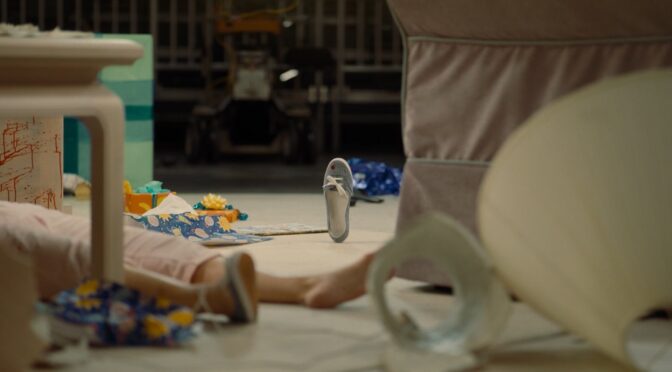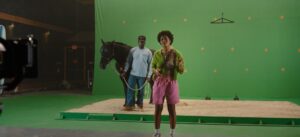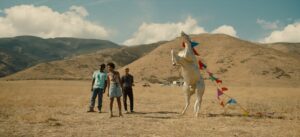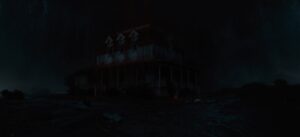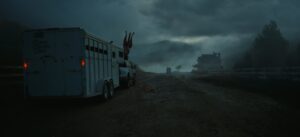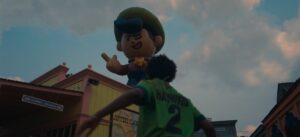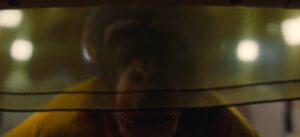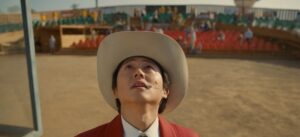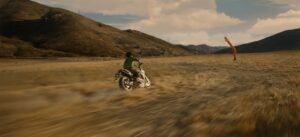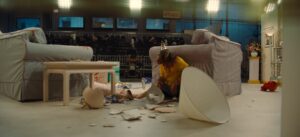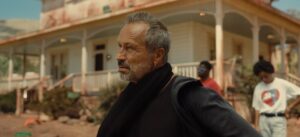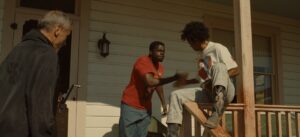I would like to start my first review of the spellbinding 2022 cinema crop with a very heartfelt apology to estimable octogenarian Polish director Jerzy Skolimowski and the six very talented donkeys who starred in his lovely, wise and animal-loving late career triumph EO. I had it sitting at number 20 with my list seemingly finalized. I was eager to watch the film again and offer up my thoughts on that astonishing, relatively wordless gem. But I’m afraid that, at the absolute 11th hour, the fates came sprinting down the hall with a last minute fax from top brass (quite the lively, Aaron Sorkian office this cinema-addled brain is!). Top 20 placement for EO was to be a reluctant, well, nope. While showing a close friend the latest David Ehrlich film countdown video, we turned to the subject of Jordan Peele’s Nope, which he had recently seen. In explaining why I had increasingly come to love it the more I sat with it, I began going into its teeming ideas and how they all mingled together or maybe didn’t. And as we parsed through them, I had a sudden epiphany about the fearsome sky predator that stalks our main cast throughout the film and how much dread Jordan Peele milks out of its nebulous shape. And that’s before we even see its shape. At first it’s just a blur, obscured by night or by cloud cover. “It’s scary how hard the creature is to pin down and describe,” my friend noted. “Right,” I replied before it suddenly hit me. “But then the Haywood siblings do find a way to describe him. They name him. He’s Jean Jacket.” I realized that, among Peele’s many insights on what scares us, he had subtly made a comment on how giving a name to something that feels beyond description and comprehension helps us reduce our fear of it. Sure, the creature is still an enormously terrifying threat, capable of eating a bleacher’s worth of people in barely an instant. But it also looks a lot like an unfolded denim jacket at one point (when it’s not looking like a big cowboy hat). And we can now laugh at the thing that frightens us. This was the moment I knew Nope had to be included in this countdown. A film so chock full of rich psychological ideas that it was still spitting new ones out at me all these months later just could not be denied. At this point, I’ll assume I’ve barely scratched the surface and that the next time I watch it a few more insights will tumble out of it. Like forgotten quarters out of an old jean jacket.
Jordan Peele’s dreadfully entertaining, awe-inspiringly anxious blockbuster thrill ride gets the special distinction of being 2022’s steadiest climber. It was outside of my top 20 on first viewing all the way back in October, even before I saw a great many other outstanding films. But Nope stubbornly stuck around, leap-frogging a film here and a couple films there every few weeks or so. This relentlessly sticky new horror adventure classic (stickier than a jar of “hobby weed’) tells the story of the Haywoods, a small black family of horse trainers living in the rocky, shrubby desert berg of Agua Dulce, north of Los Angeles. They live on the far outskirts of the Hollywood Dream, but close enough for the aging father of the family (a brief but memorable appearance by the legendary Keith David) to have made a respectable living providing horses to the motion pictures. The Haywoods are meant for the movies, whether the big studio system knows it or not. They even descend from the first man to ever appear in a recorded image, a black jockey filmed for a few moments riding a horse. It’s the day that the Haywoods are to get one of their biggest breaks. They’re first in line to provide horse power to a bona fide Hollywood blockbuster, the kind of opportunity the Haywood paterfamilias has been building toward his entire career. But an unimaginable and wildly improbable tragedy strikes the Haywood Ranch. A bunch of falling debris rains down from the sky (falsely attributed to a prop plane flying overhead) and an errant quarter pierces the old man’s eye socket and kills him. This leaves it to his children to go to the film shoot and hold onto the gig. They are the very shy and soft-spoken salt-of-the-earth son, OJ (splendidly played by Peele’s already strastospheric Get Out muse Daniel Kaluuya, in an entirely different register than I’ve seen him) and his quick-witted, livewire sister Emerald (Keke Davis, the effervescent heart that keeps this often disquieting film buoyant and consistently fun). Despite the siblings’ best efforts, the horse has trouble staying calm under the hot lights and hubbub of a big budget production. With one harmless but alarming kick of the beast’s hind legs, the Haywoods are let go on the first day. “Thank you for the opportunity,” OJ mutters dejectedly. In the wake of his father’s death and doubts about the family’s future in the movies, OJ reveals to Emerald that he has begun selling off some of the horses to Noah Jupe (the always welcome Steven Yeun), a former child actor who has parlayed his short-lived time in the spotlight into a stake as the owner of a modest, tacky Western-themed amusement park called Jupe’s Claim. The Claim, in all its small-scale success, sits just next to the Haywood Ranch, a mocking reminder of the Haywoods’ own stalled show business dreams. We learn of Jupe’s first acting gig, a sitcom called “Gordy’s Place”, which went off the air early in its second season after its major star, a trained chimpanzee, went on a bloody and fatal rampage. Jupe keeps a small museum to his dark entertainment survival story in the secret room behind his office. Emerald and OJ are enjoying a night of drinking, smoking and catching up when OJ notices his father’s old horse, Ghost, out in the corral after dark. The beast seems unsettled. As OJ tries to coax him in, all the lights in the ranch house go off. More curiously, Emerald’s cell phone shuts down. She suspects a real-life UFO could be out there and sees a last-ditch way for the striving siblings to saty in the entertainment game: by being the first to catch an honest-to-God alien sighting on camera. A real quality image too, not your standard blurry fake. To save the family farm (one of many tropes Nope plays with), the Haywoods will need what Emerald calls The Oprah Shot. The kind of iconic, gob-smacking image that will not only kickstart their reputations but make them rich and famous for life. As Peele builds his film’s unsurprisingly strong comedic rhythm, partly through the addition of a conspiracy-minded Fry’s tech worker named Angel (Brandon Perea, a great find), he also ratchets up the tension to rareified levels. Nope is both a hilariously poignant show biz satire and a viscerally unnerving sci-fi creature feature. After the admirably bold Us, Nope sees him back at the sort of horror-humor blending he mastered in his seminal debut Get Out. He giddily stretches the boundaries of how rib-tickling a white knuckle survival thriller can be and how shockingly bloody and even mournful a big, fun studio comedy can be.
At the movie’s heart is the idea of spectacle. Maybe you hear the word and think of the adjective “spectacular”. And “action spectacular” is certainly one of the major veins Nope is working in. What Peele has assembled is breathtaking and beautiful, but that is not all it is. Spectacle can also have a sinister undercurrent to it. Horrific car crashes can be spectacles. A vicious street brawl is a spectacle. Natural disasters are spectacles. Peele starts his film with a quote from the Bible about spectacle that associates it with “abominable filth”. Nope is spectacular in the best ways from Hoyt van Hoytema’s crisply pulse-pounding shot compositions to its imaginative setpieces to the ingenious effects design of its creature (whose very existence calls out the soulless spectacle of an action landscaped dominated by ugly, muddy CGI monstrosities). But Nope is also a film about our dark impulse to look at what many refer to as cursed images. The primal drive to look at things that are nasty, debasing, upsetting. Nope brilliantly manages to have its cake (or maybe blood pudding would be more applicable) and eat it too. Peele captivates and disgusts in equal measure and in so doing reminds us why he has volumes more to say about what makes horror tick. What makes Nope so much more remarkable than every other monster movie or violent blockbuster is Peele’s willingness to go further into the nucleus of fear. To plumb the very core of what makes things scary. We’ve seen any number of gargantuan beasties attack cities and devour the helpless victims in its path, but so much of Hollywood spectacle feels bloodless and, for all the T-Rexes and gnashing aliens it summons, toothless. Peele has that fateful way (rooted as much in his comedian’s instinct as anywhere else) of going too far, which is exactly as far as he needs to go. Without saying too much, Nope contains the most fundamentally upsetting scene I saw all year. I had put on Nope to enjoy some good old fashioned terror and destruction and now Peele was calling my bluff. If there is a vicious monster in the sky, why not see what it does to its prey? Why not revel in the terror of what happens when it has to digest its food thousands of feet up in the air. If a violent animal attack is central to the theme and emotion of the film, Peele sees no reason to cheat; no reason not to take us all the way there. And these uncomfortable (the most timid might even say questionable) choices are not mere shock tactics. They are calling humanity out, asking people to reflect on their attraction to carnage. Our inclination to look at death and mayhem for a giddy little thrill but to only look so closely or for so long. Every month of every year, audiences cry out for a big, cheaply destructive display to sate their so-called appetites. But what Hollywood routinely gives them is barely even an appetizer. In Nope’s most chillingly memorable setpiece, Peele answers the public’s call for scares and gore with a blood-and-terror banquet; a smorgasbord fit for the Ghost of Christmas Present. He wants to see if we’re really as hungry for this kind of thing as we say we are.
That is not to say Peele is doing any of this in a sneering or judgmental way. He seems genuinely fascinated by what draws the human gaze to terrible, mortifying images, in movies and elsewhere. What he sees in Nope is how art can give us a way to process trauma, a veil to help look at painful things safely, and how it can simultaneously be a mirror reflecting our deepest fears and anxieties back at us. In a bravura monologue, Jupe tells Emerald about the horrendous animal attack he survived as a 9-year old boy, but he doesn’t describe the tragedy directly. Instead, he breathlessly recounts the SNL sketch that it inspired. He is able to talk in gushing tones about his emotionally debilitating brush with death because this version isn’t the one that actually happened to him. He can laugh and talk enthusiastically about how it went viral and how incredible Chris Kattan was at playing the enraged chimpanzee. Art and comedy become a way of safely staring into the Sun. Still, the glazed look in Jupe’s eyes tells us some part of him is a million miles away. Art can give us a way to process our pain, but maybe we also use it as a means of masochistically revisiting that pain and holding on to it. Jupe keeps mementos of the chimp attack behind glass cases. But this is not memorabilia to remind him of his first show business opportunity. They are souvenirs of psychological scarring. Why is there some part of us that can’t stop walking back into our own version of Jupe’s hidden room? The mental space where we store all the worst things that ever happened to us. The complex tangle of that question is at the heart of what makes the horror genre so wildly successful every single year. When the appearance of something grand and supernatural and fearsome hovering over his theme park allows Jupe to concoct a new out-of-this-world experience for his guests, part of that is maybe just a mercenary cash grab. The same way charging pop culture tourists to look at props from “Gordy’s Place” is a cash grab. But there is also something else to it. Something more damaged, forlorn and self-destructive in the impulse. And what really makes all of this such a bold coup for Jordan Peele is how all of this business about internalizing trauma and punishing ourselves for past suffering is handled subtextually. Nope never stops to speechify or explain and it is that facet that makes it both entertainingly immediate and rewarding to revisit. I imagine we’ll be marveling at, and digging through, its juicy, disturbing layers of excitement and anguish for years and years to come.
When Nope debuted over the summer of 2022, Peele suddenly found himself earning comparisons to an old master. It was an achievement that even the indelibly perfect Get Out had not managed. Peele’s hybrid of giddy rollercoaster energy and sly psychological depth brought one man to mind: Steven Spielberg. The Jaws comparisons were as obvious as they were well-earned. Just as Spielberg’s 1975 blockbuster-inventing masterpiece used an almost faceless, implacable force of nature to forever make the ocean feel unsafe, Peele had used a faceless force of nature to make the entire sky feel perilous. But Nope deserves more than just a favorable comparison to one film. What Peele has is Spielberg’s sense (the notion the old man digs into so perceptively in his newest masterpiece The Fabelmans) of how dazzling imagery and ominous undertones go hand in hand. About the thin line between awe and fear and how elation and anxiety feed into one another, sometimes to the point where the border between the two becomes imperceptible. On my second viewing of Nope, I was gushing over the sheer technical wonder of Jean Jacket hovering over Jupe (just out of our sight) and then recoiled at a detail I had only caught this time. The dark flickers in the stadium dust around Jupe aren’t just from the creature’s own imposing shadow. We’re seeing the shadows of the fifty spectators Jean Jacket is sucking up. I once had an awful nightmare where I saw corpses lying on a freeway as I was passing by in a bus. But the worst thing wasn’t seeing the bodies. It was in the split second before I knew they were bodies, when a woman’s devastating scream rang out behind me. Her choked agony was unspeakable. Before I registered what I was looking at, I knew that I was in the presence of something sickening and mortifying. Jupe’s final showdown with the natural world took me to that realm of fear. It finds the special even more potent horror experienced in the moments right before we fully understand what it is we are seeing. And then Peele immediately scares us again by showing us absolutely everything. Nope also does Jaws one better in how it characterizes the natural world. Like Nope, Jaws‘ real antagonist was man’s greed and callous exploitation. But Spielberg always felt bad about how much he vilified the shark; how his film influenced negative impressions about the threat the animals pose to us. Peele has made a more nuanced film, animal-loving about man’s often crass, greedy relationship to nature. He’s obviously helped by the fact that people aren’t going to go out and start spreading harmful urban myths about whatever kind of creature Jean Jacket is. But his film, in its critical musings on the use of animals for entertainment and profit, also feels more interested in how we can better respect the creatures we share a world with. It is that very respect and humility that sees the Haywoods through their dark and dangerous weekend. And in this regard, I can feel a mite less guilty about having to leave EO off my top list. Nope honors the spirit of EO in its own rollicking way. Even the fearsome thing in the sky is just an animal trying to stay alive. In the end, even as we root for our human protagonists to survive, Nope similarly wants us to see how human ignorance and vice can thrust innocent animals into situations they never asked for and could never hope to comprehend.
And with all these rich ideas cooking in this beautifully lensed neo-Western stock pot, there surely could not be room for any more. And yet. And yet, there is still the matter of the Haywoods themselves. Who are, at the end of the day, only our main characters. You might ask, where do they fit into Nope‘s themes? The Jupe storyline brings the theme of trauma. Jean Jacket is the constant source of horror. And Jean Jacket, the horses and one overworked, blood-soaked chimpanzee all tie into Nope‘s meditation on animal exploitation. All of them used to further capitalist ends and then demonized when they lash out or act according to their wild natures. So what of the Haywoods? Nope is a film of richly subtle subtext and Peele likes it that way. If anyone can’t see where two outmatched, slept on, underemployed black Americans relate to themes of trauma, exploitation and existential horror, Jordan Peele is not the kind of filmmaker to underline those connections. It all works better left to implication anyway. It also makes sense to just let the Haywoods be fun, likable, outstandingly acted characters without having to do a lot of symbolic heavy lifting. Peele mostly just wants to give them what they are denied at the start of the film: an opportunity. He wants to give them a story where they get to be as interesting, funny, relatable and human as they damn well want to be. On first viewing, I wondered if Nope‘s ideas, thought-provoking as they are, tied together neatly enough. Now I think all of them, including its fiercely eloquent ideas about blackness (in the Industry and out in the wide world) knit together just fine. It’s a film not just about animal exploitation but exploitation of marginalized beings of all kinds. It contemplates the fundamental meanness of an industry or a society that demeans and undervalues and callously throws away. It’s all there, including in the shout out to former SNL performer Chris Kattan (a committed physical performer who Hollywood just never found a lasting place for) and the perfect casting of character actor Michael Wincott (a man whose singularly unusual face and raspy voice prevented him from ever truly breaking out). But it’s especially there in the underdog Haywoods. It’s a film about vindication for the exploited and underestimated and it is fittingly the Haywoods who lead the charge. Peele wants the good and the downtrodden to survive this time. In an acid-black film, it’s that consistent note of sweet humanity for its two black characters that keeps Nope from getting sucked up into a despairing void. We travel through the trenches of terror but it’s a lot of fun and we eventually end up somewhere hopeful. How very Spielbergian. How very much like Jordan Peele.
